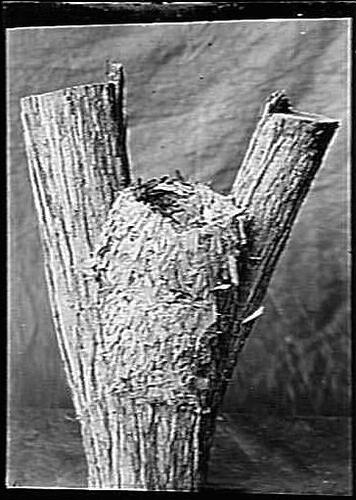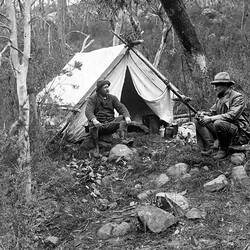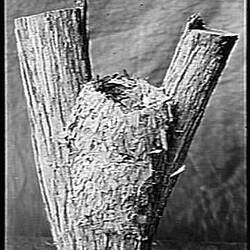WHITE-HEADED TREE RUNNER
Sittella Leucocephala, Gould - (374)
Geographical Distribution - South Queensland and New South Wales.
Nest - Neat, small, open, upright; composed of spiders' webs and cocoons, covered outwardly with small pieces of greying bark placed parallel with and resembling the figure of the bark of the branch holding the nest - altogether a wonderful piece of mimicry both as regards colour and form of the nest; inside deep and lined with soft bark, spider and other insect cocoons. Usually situated in an upright, dead, forked branch near the top of a tree. The nest has an elastic tendency, and when removed from its resting-place readily contracts. Dimensions over all, 2 ¼ inches by 2 ½ inches in depth (or to the prong of the branch); egg cavity, 1 ½ inches across by 1 ¼ inches deep.
Eggs - Clutch, three; roundish in form; texture of shell fine; surface glossy; colour, greyish-white, boldly blotched and spotted with sepia and slate. The eggs of the various species of Sitelloe are almost insep-arable from each other as far as appearance goes. But the eggs of the White-headed bird are slightly smaller than those of the southern forms. Dimensions in inches of a proper pair; (1) .63 x .51 (1) .62 x .5.
Observations - This sprightly Sittella is at home in the more inland portions of Southern Queensland, but it also frequents the northern parts of New South Wales. It is readily separated from its southern congeners by the pure white colouring of the head, hence its appropriate vernacular name; but the Pied Tree Runner has also a white head.
During my brief sojourn at Coomooboolaroo (Q.), October, 1885, most unfortunately I found the country suffering from the visitation of a disastrous drought. The cattle dead and dying on the station had a depressing effect on a stranger's feelings. What must it have been to the owners, Mr. George Barnard and his sons? As a matter of course, and although the breeding season for birds had fairly commenced, numerous species had not laid. Nothing has such a retarding tendency on the breeding instincts of birds as a droughty season.
However, strolling alone one day on the margin of a dry Brigalow scrub, I noticed some White-headed Tree Runners attentively examining or working at what appeared to be a notch on a dead topmost branch. This notch on closer inspection I found to be a nest which the little birds were constructing. This was encouraging, for the nest and eggs of this species had not yet been described. A further search in another direction discovered a second nest also in the course of construction. I left the nests as long as I could, even to the day before I left Coomooboolaroo (9th October), when Mr. Harry Barnard kindly ascended the trees and secured me the prizes - a pair of eggs from each nest. Great difficulty attended the taking of one nest, which was in an upright fork of a dead limb. This branch had to be sawn through and lowered gradually till it reached my hands below. Subsequently I made a photograph of it. (see illustration). These finds were reported to and duly recorded by the Field Naturalists' Club of Victoria.
Subsequently (1889) Mr. North independently described the eggs of the White-headed Sittella from the same locality, and was indebted, as he states, to the late Mr. Geo. Barnard for the same.
Breeding season, chiefly the months of September, October and November.
Resources
Transcribed from Archibald James Campbell. Nests and Eggs of Australian Birds, including the Geographical Distribution of the Species and Popular Observations Thereon, Pawson & Brailsford, Sheffield, England, 1900, pp. 339-340.
More Information
-
Keywords
-
Authors
-
Contributors
-
Article types


